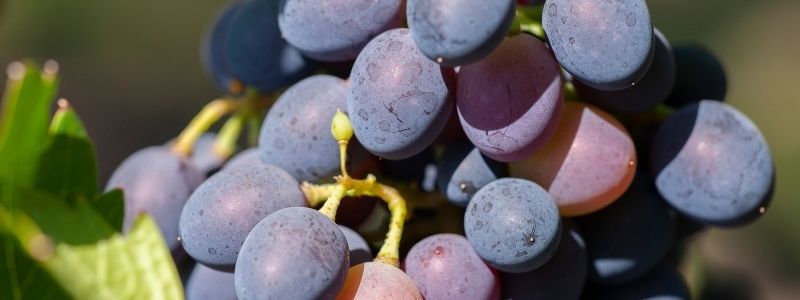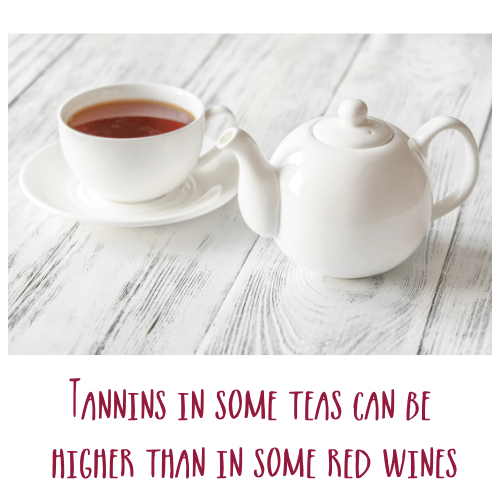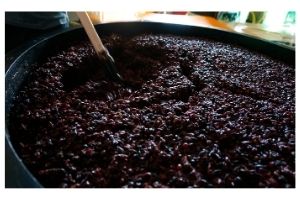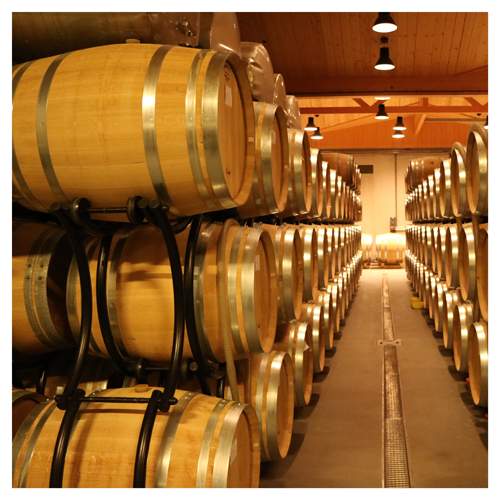No products in the basket.

Tannins in wine tend to have a bad press but is it justified? This blogpost takes a look at exactly what tannin is and how you can detect it in wine, which wines are the most tannic and which the least and how levels of tannin can be altered during wine-making and during ageing from the effects of oak. I’ll also cover the best foods to match with tannic wines and try to answer whether tannins are good or evil.
Firstly, let’s look at how to detect whether the wine you are drinking is tannic.
It is in fact impossible to describe the smell or taste of tannins. It is easier to detect them through the sensations they create in the mouth…
When taking my Diploma in Wine & Spirits I asked almost every lecturer and wine expert that came to talk to my class at the Wine & Spirit Education Trust how tannins can be detected and measured particularly as we were expected to describe tannins with words such as ripe, soft, green, stalky, chewy, coarse and fine-grained. It is very hard to describe how they can be measured and there were a lot of attempts to answer my question but the best explanation came from Michelle Cherutti-Kowal, now a Master of Wine, and it helped immeasurably in my general understanding of tannins and in those descriptions required for the blind wine tasting exams.
Here’s how to tell if a wine has tannins and what kind they are, whether coarse or fine for example. When you have a small amount of wine in your mouth, keeping your mouth closed, carefully rub your tongue over your top front teeth. With a tannic wine you can feel a bit of roughness on the teeth. Try it with several different wines and you will begin to be able to differentiate between coarse- and fine-grained tannins, wines with finer tannins feeling slightly smoother on the teeth than those with coarser tannins.
In addition tannins leave you with an astringent sensation in the mouth, astringency being detectable by a mouth-puckering dryness on the inside of your cheeks such as you would get from sucking on a lemon. This feeling is caused by tannins interacting with proteins in the saliva; this interaction dries out the mouth. Some say that tannins create a bitter taste but in fact it is astringency evidenced in highly astringent wines by a chalky, powdery feeling in the cheeks but in less astringent wines with balanced or low tannins by a smooth silky texture.

In the vineyard as grapes develop and ripen in the sunshine and warmth, the tannins in the skins and pips soften and become less astringent. Grapes grown in warm climate wine regions have more chance of creating wines with softer tannins than grapes grown in cool climate areas. The best time to harvest black grapes isn’t just about reaching the optimal level of sugar and acidity in the grapes but also about making sure the tannins are ripe and not too “green”.

To understand tannins in wine and the effect they have, it helps to know where they come from. Tannins are found in many plants like the vine, tea plants and rhubarb. On the vine they are concentrated in the skins of grapes but are also found in the pips and in the stalks and leaves of the vine itself. Without being too technical, tannins are natural compounds and as mentioned above they react with proteins to make an unpleasant astringent sensation, thought to be nature’s way of deterring animals from nibbling on some plants.
I am often asked if white wines have tannins. In fact since all grapes have skin and almost all have pips, all wines have them but to varying degrees. And in general white wines and rosé will have fewer but the level of tannins depends on a number of factors – all of which I expand on below – such as the amount of time on the vine before harvesting, the grape variety itself and on the wine-making process.
Some grapes are naturally higher in tannin than others. Grapes that are particularly high (often thicker-skinned grapes) include Cabernet Sauvignon (think of young Left Bank Bordeaux wines), Shiraz, Sangiovese, Nebbiolo, Malbec and Pinotage.
But bear in mind that this does not mean that all wines made from Cabernet Sauvignon for example will display high levels of tannins because so much depends on the vintage and on the way the grapes have been treated in the vineyard and in the winery.
In general younger red wines will have harsher tannins than aged red wines but, if they are well-made wines, their tannins will soften after ageing in a vat or in bottle.
Grapes that are naturally low in tannins include Pinot Noir, Dolcetto and Gamay. In a similar vein this does not mean that all Gamays for example will be low in tannins because winemakers could for example ferment and age the wine in new oak barrels, the effects of which are explained below. Grenache and Merlot are also fairly low in them.
In general white wines have lower levels of tannins because of the way they are processed during wine-making.
Tannins change during the wine making process and during ageing but the chemical process is still not fully understood despite numerous research projects.
Aside from the ripeness of the tannins when the grapes are picked, the following can have a significant effect on the level of tannins in wine:

In making red wine production it is essential to extract colour and flavours from the skins of the grapes and therefore tannins are unavoidable. The key is not to over-extract. For white wine the juice of the grapes is fermented after removal of the skins to reduce the risk of oxidation and therefore white wines generally have fewer tannins. Orange wines however, essentially white wines that have been fermented with skins and pips, will necessarily have higher tannins.
– The pressure used in pressing the grapes
If pressed too harshly the structure of grape skins breaks creating a higher extraction of tannins. Pressing machines have been developed with an inflatable cushion inside that presses grapes gently. Most gentle for premium white wines is the process known as whole bunch pressing where just the pressure of the bunches of grapes causes grapes below to burst and the juice runs free with minimal contact with skins.
– The fermentation temperature
Higher fermentation temperatures will generally extract more tannins and colour in red wines.
What may be less widely known is that wines may also acquire tannins if fermented and / or aged in oak barrels – the newer the barrel generally the more tannins are present in the wood and thus leach into the wine. Oak chips or staves in a stainless steel vat will have the same effect (and tannin powder can even be added).
Research continues to be carried out into how the tannins change in the presence of oak but previous theories about how they are softened is currently being challenged. Ageing does seem to soften tannins however whether a wine is aged in barrel or in bottle.

Whenever I read wine descriptions with the word tannins it is hard not to detect a note of negativity – even in writing this blog post I am consciously trying not to make tannins sound like a bad thing. And they need not be a bad thing.
Yes, they can be astringent. But tannins aren’t the only thing that can make wine astringent and needn’t do so if managed well by winemakers as we have seen above. Tannins are only really evil if they are handled badly.
On the positive side, tannins help to add character, structure, body and texture to wine and are vital for wines that are meant to be kept for several years before drinking – though there are different theories about how tannins help wine age. Tannins are also an antioxidant. In the right wine and when in balance with a wine’s acidity, sweetness, fruit and alcohol, tannins are a good thing.
As an aside, tannins are not a known allergen but I do recommend to anyone who says that they get headaches from red wine to avoid a tannic wine that has been aged in oak and to stick to the lower tannic grape varieties.
Is it just me or do you also think that wines generally are becoming less tannic? I don’t think my subconscious is pushing me away from more tannic wines when I choose red wine. But when I taste (and spit out) wines in my search for those worthy of the Wines With Attitude list I have noticed that there seem to be fewer wines with high levels of tannins these days. I have been wondering why that is.
Like most things tannins move in and out of fashion and I think we are currently in a period where low tannic, smooth and easy-to-drink wines are the preference. Understandably winemakers are keen to follow that trend in order to sell their wines. But I also believe that the understanding of tannins by winemakers is improving constantly as more and more research is done into them and their effects on the taste and structure of wine. This means that the tannins in wine are generally being managed more effectively.
And finally…

Did you know that serving red wine at a cool temperature can make the tannins more obvious? You may want to make sure you serve wines high in tannins at room temperature. And in general wines that are high in tannins will taste better when consumed with food.
Tannins are known to help break down proteins in meat particularly red meat, one of the reasons red wine is usually suggested for drinking with red meat (although as regular followers of my blog will know matching your food and wine should first take the weight of the food into consideration). Fat in rich sauces or in fattier cuts of meat like pork belly or rib-eye steak can mask the flavours of the meat and wine but a tannic wine will cut through the fat and make those more intricate flavours more pronounced.
And it would be better not to drink highly tannic wines with salty foods like roast ham.
© 2014-2025 Wines with Attitude Ltd | VAT Reg. No. 181 2419 22 | Registered in England 08918466 | Fiveways, 57-59 Hatfield Road, Potters Bar, Herts, EN6 1HS